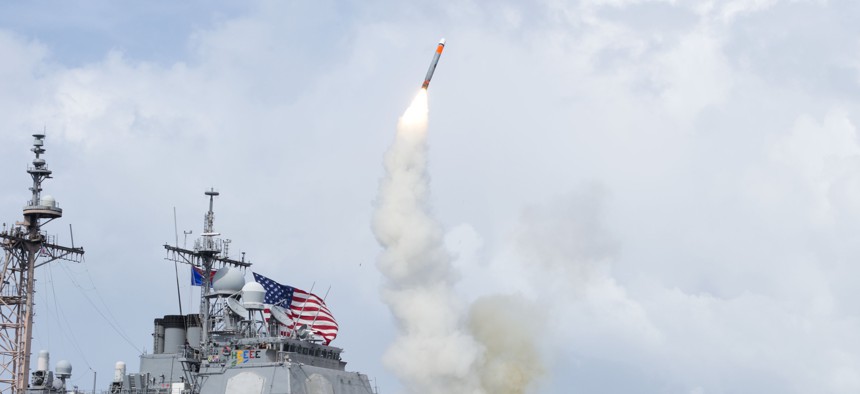Save the Tomahawk
The U.S. Navy wants to stop production of America’s most useful long-range missile, betting that a replacement will arrive without delay.
America’s long-range land-attack cruise missiles have been an indispensable element of every major military action for more than two decades — including the 2017 and 2018 strikes to punish the Syrian regime for using chemical weapons. Unfortunately, acquisition officials and lawmakers appear poised to cut off production of these deep-strike weapons even as our need for them is increasing.
Developed and first fielded in the 1980s, cruise-missile technology allowed America to hit targets deep in enemy territory without subjecting pilots to dangerous enemy fire. Launched by standoff aircraft, warships, or stealthy submerged submarines, the Tomahawk and its ilk fly at very low altitudes, where they are hard to detect and even harder to shoot down. These attributes, plus accuracy that can minimize civilian casualties and other collateral damage, have made cruise missiles the undisputed first choice of military strike planners for the U.S. and our allies.
Initially configured as autonomous fire-and-forget weapons, deep-strike cruise missiles like Tomahawk and Conventional Air Launch Cruise Missiles have evolved. Today’s versions mimic many traits of manned aircraft, incorporating GPS and satellite communications to allow loiter capability, specific target identification, increased survivability, longer range, mid-course guidance, and even the ability to hit moving targets in anti-ship variants.
Perhaps the best evidence for these missiles’ success are the Russian and Chinese efforts to copy them and counter them. Earlier detection at longer ranges, spoofing, jamming, and improved kinetic solutions such as Russia’s S-400 interceptor are all aimed at lowering Tomahawk’s 85 percent-plus hit rate.
Like any weapon, Tomahawk will ultimately require replacement — and improvements in enemy tech means the need is urgent. The main lines of effort to create a faster, stealthier, more lethal precision strike weapon include the Long Range Anti-Ship Missile, or LRASM, and the Next Generation Land Attack weapon, or NGLAW. Scheduled for introduction in roughly 2025 and 2030 respectively, follow-on weapons to Tomahawk could be supersonic or hypersonic, even more accurate, highly agile, and effective even in a challenging electronic warfare and counter-missile environment.
But that’s only on paper. “Out-year” upgrades for complex, new-technology military systems have a nasty habit of arriving in the fleet a lot later than planned.
Which is why we should do everything we can to prevent the cuts to the Tomahawk purchase line and the proposed halt to production. When we lack so much as a firm design for follow-on weapons procurement, it only makes sense to continue to fund and upgrade working systems until we have a fully tested, fully integrated, and fully stocked arsenal of replacement missiles— especially when we are using them up at a rate greater than planned.
Acquisition professionals are possessed of the seemingly congenital habit of under-estimating resource and schedule requirements for new systems and then paying for their mistakes from the readiness and procurement accounts of systems to be replaced. Whether with bombers, fighters, helicopters or howitzers, new systems are seldom ready on time, always cost more than rosy original estimates, and are bought in numbers insufficient to satisfy current requirements.
This generally results in more expense, as existing systems are kept in service via Band-Aid solutions while the promised replacements make their belated way to the front lines. Worse, the services are sometimes forced to reopen closed production lines at exorbitant cost.
The U.S. simply cannot allow to occur with the “main battery” of standoff weapons. Unmanned deep-strike weapons like Tomahawk are not optional, or “nice to have.” More than most weapons in our inventory, they exist as a credible threat, a strong deterrence, a means to project power and enforce the political will of the U.S. and our allies in ways that other capabilities can’t. We need them at a moment’s notice, and we can’t afford for our adversaries to assume their absence or ineffectiveness. Their use must be guaranteed. Sufficient quantities must be assured. Stopping their production, as Congress would have U.S. do in 2019, is simply unacceptable in a dangerous and uncertain world.




